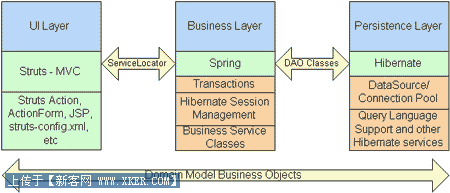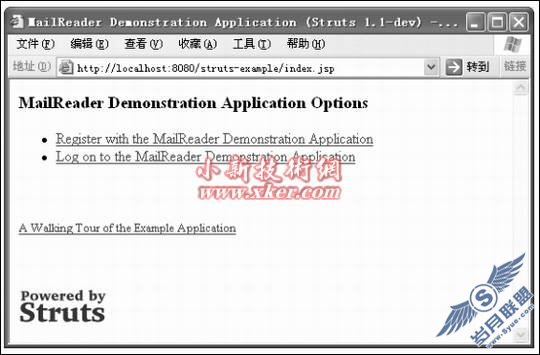JSTL和EL介绍
JSTL规范介绍
------------------------------------------------
JSTL:
* JSTL即JSP Standard Tag Library的缩写
* 一些常用的JSP标签
* 和MVC框架结合使用很方便,如果struts、spring mvc
* 不是JSP 1.2,2.0,2.1规范的一部分,需要单独下载。下表是servlet、jsp、jstl、j2ee规范的对应关系:
Servlet Version JSP Version JSTL Version Java EE Version
2.5 2.1 1.2 5
2.4 2.0 1.1 1.4
2.3 1.2 1.0 1.2
EL:
* EL即JSP Expression Language(JSP表达式语言)
* EL来源于JSTL,jsp 2.0、2.1中已实现了EL规范
注:本文是按照jstl1.2的规范来介绍的,sql和xml标签未做介绍!
Core Tags(核心标签)
------------------------------------------------
<%@ taglib prefix="c" uri="http://java.sun.com/jsp/jstl/core" %>
<c:out>
语法:
<c:out value=”value” [escapeXml=”{true|false}”] [default=”defaultValue”] />
描述:
输出一个表达式的值,和 <%= ... > scriptlet类似,但在c:out中可以用'.'访问对象属性值。
例子:
<c:out value="${'<tag> , &'}"/> >>>>> <tag> , &
<c:out value="${customer.address.street}"/>==${customer.address.street}(JSP2.0/2.1) >>>>> street的值
EL表达式的取值默认顺序:pageScope requestScope sessionScope applicationScope
<c:out value="${requestScope.foo}"/>
<c:out value="${requestScope['foo']}"/>
<c:out value="${param['foo']}"/>
<c:out value="${param['foo']}"/>
<c:out value="${paramValues['foo']}"/>
<c:set>
语法:
<c:set value=”value” var=”varName” [scope=”{ page|request|session|application}”]/>
<c:set value=”value” target=”target” property=”propertyName”/>
描述:
将表达式计算出来的值赋值给某一变量或map中的对象
例子:
<c:set var="foo" value="${foo2 * 2}" scope="page"/> scope="{page|request|session|application}"
<c:set target="${cust.address}" property="city" value="wuhan..."/>
<c:set target="${myMap}" property="color" value="red"/>
<c:remove>
语法:
<c:remove var=”varName” [scope=”{page|request|session|application}”]/>
描述:
从不同的scope中删除某变量,没有指定scope,则从PageContext中删除对象
例子:
<c:remove var=”myVar”/>
<c:catch>
语法:
<c:catch [var=”varName”]>
nested actions
</c:catch>
描述:
捕获标签内部的java.lang.Throwable
例子:
<c:catch var ="catchException">
<% int x = 5/0;%>
</c:catch>
<c:if test = "${catchException != null}">
<p>The exception is : ${catchException} <br />
There is an exception: ${catchException.message}</p>
</c:if>
<c:if>
语法:
<c:if test=”testCondition ” [var=”varName”] [scope=”{page|request|session|application}”]>
body content
</c:if>
描述:
如果表达式判断为true,则会执行标签体内的内容
例子:
<c:set var="salary" scope="session" value="${2000*2}"/>
<c:if test="${salary > 2000}">
<p>My salary is: <c:out value="${salary}"/><p>
</c:if>
<c:choose>,<c:when>,<c:otherwise>
和switch类似
<c:choose>
<c:when test="${salary <= 0}">
Salary is very low to survive.
</c:when>
<c:when test="${salary > 1000}">
Salary is very good.
</c:when>
<c:otherwise>
No comment sir...
</c:otherwise>
</c:choose>
<c:import>,<c:param>
语法:
<c:import url=”url” [context=”context”] [var=”varName”] [scope=”{page|request|session|application}”] [charEncoding=”charEncoding”]>
optional body content for <c:param name=”name” value=”value”/> subtags
</c:import>
描述:
<c:import>和<jsp:include>动作类似,但是c:import可以从其他的站点或FTP获取资源
例子:
<c:import var="data" url="http://www.tutorialspoint.com"/>
<c:out value="${data}"/>
<c:forEach>
语法:
<c:forEach [var=”varName”] items=”collection” [varStatus=”varStatusName ”] [begin=” begin”] [end=”end ”] [step=”step”]>
body content
</c:forEach>
<c:forEach [var=”varName”] [varStatus=”varStatusName ”] begin=”begin” end=”end” [step=”step”]>
body content
</c:forEach>
描述:
根据给定的集合变量,循环输出标签体的信息。或者将标签体的信息循环指定次数。
status变量包含属性
current:当前这次迭代的(集合中的)项
index:当前这次迭代从 0 开始的迭代索引
count:当前这次迭代从 1 开始的迭代计数
first:用来表明当前这轮迭代是否为第一次迭代的标志
last:用来表明当前这轮迭代是否为最后一次迭代的标志
begin:begin属性值
end:end属性值
step:step属性值
例子:
<c:forEach var="i" begin="1" end="5">
Item <c:out value="${i}"/>
</c:forEach>
<c:forEach var="m" items="${myMap}" begin="1" end="5" varStatus="stat">
Item <c:out value="${m.color}"/>
<c:if test="${stat.last}">
last....
</c:if>
</c:forEach>
<c:forTokens>
语法:
<c:forTokens items="stringOfTokens" delims="delimiters" [var="varName"] [varStatus="varStatusName "] [begin=" begin"] [end="end "] [step="step"]>
body content
</c:forTokens>
描述:
遍历有分隔符号的字符串
例子:
<c:forTokens items="Zara,nuha,roshy" delims="," var="name">
<c:out value="${name}"/>
</c:forTokens>
<c:redirect>
语法:
<c:redirect url=”value” [context=”context”]/>
<c:redirect url=”value” [context=”context”]>
<c:param name=".." value=".."/>
</c:redirect>
描述:
和HttpServletResponse.sendRedirect()类似
例子:
<c:redirect url="http://www.photofuntoos.com">
<c:param name="a" value="hello"/>
</c:redirect>
<c:url>
语法
<c:url value=”value” [context=”context”] [var=”varName”] [scope=”{page|request|session|application}”]/>
<c:url value=”value” [context=”context”] [var=”varName”] [scope=”{page|request|session|application}”]>
<c:param name=".." value=".." />
</c:url>
描述:
构建一个URL
例子:
<a href="<c:url value="/jsp/index.htm"/>">TEST</a>
Formatting tags(格式化标签)
------------------------------------------------
<%@ taglib prefix="fmt" uri="http://java.sun.com/jsp/jstl/fmt" %>
<fmt:formatNumber>
语法:
<fmt:formatNumber value=”numericValue” [type=”{ number|currency|percent}”] [pattern=”customPattern ”] [currencyCode=”currencyCode”] [currencySymbol=”currencySymbol”]
[groupingUsed=”{true|false}”] [maxIntegerDigits= ”maxIntegerDigits” ] [minIntegerDigits= ”minIntegerDigits” ] [maxFractionDigits=”maxFractionDigits”]
[minFractionDigits=”minFractionDigits”] [var=”varName”] [scope=”{page|request|session|application}”]/>
描述:
格式化数字
例子:
<c:set var="balance" value="120000.2309" />
<fmt:formatNumber value="${balance}" type="currency"/> ---->>> ¥120,000.23
<fmt:formatNumber type="number" value="${balance}" /> ---->>> 120,000.231
<fmt:formatNumber type="percent" value="${balance}" /> ---->>> 12,000,023%
<fmt:setLocale value="en_US"/>
<fmt:formatNumber value="${balance}" type="currency"/> ---->>> $120,000.23
<fmt:parseNumber>
语法:
<fmt:parseNumber value= ”numericValue” [type=”{ number|currency|percent}”] [pattern=”customPattern ”] [parseLocale=”parseLocale”]
[integerOnly=”{true|false}”]
[var=”varName”]
[scope=”{page|request|session|application}”]/>
描述:
字符串解析成数字、货币、百分数
例子:
<fmt:parseNumber value="1234567890" type="number"/> ----->>> 1234567890
<fmt:parseNumber value="78761234.3%" type="percent"/> ----->>> 787612.343
<fmt:parseNumber type="number" value="56a" /> ----->>> 56
<fmt:formatDate>
语法:
<fmt:formatDate value="date" [type="{time| date|both}"] [dateStyle="{ default|short|medium|long|full}"]
[timeStyle="{ default|short|medium|long|full}"] [pattern="customPattern "] [timeZone="timeZone"] [var="varName"]
[scope="{page|request|session|application}"]/>
描述:
按照设置的格式,格式化日期和/或时间
例子:
<c:set var="now" value="<%=new java.util.Date()%>" />
<fmt:formatDate type="time" value="${now}" /> ----->>> 11:50:10
<fmt:formatDate type="date" value="${now}" /> ----->>> 2012-8-21
<fmt:formatDate type="both" value="${now}" /> ----->>> 2012-8-21 11:50:10
<fmt:formatDate type="both" dateStyle="short" timeStyle="short" value="${now}" /> ----->>> 12-8-21 上午11:50
<fmt:formatDate pattern="yyyy-MM-dd HH:mm:ss" value="${now}" /> ----->>> 2012-08-21 11:50:10
<fmt:parseDate>
语法:
<fmt:parseDate value=”dateString” [type=”{time| date|both}”] [dateStyle=”{ default|short|medium|long|full}”] [timeStyle=”{ default|short|medium|long|full}”]
[pattern=”customPattern ”] [timeZone=”timeZone ”] [parseLocale=”parseLocale”] [var=”varName”]
[scope=”{page|request|session|application}”]/>
描述:
将字符串转成指定格式的日期和/或时间
例子:
<fmt:parseDate value="20-10-2010" pattern="dd-MM-yyyy" /> ----->>> Wed Oct 20 00:00:00 CST 2010
<fmt:bundle>、<fmt:setBundle>、<fmt:setLocale>
语法:
<fmt:bundle basename=”basename” [prefix=”prefix”]>
body content
</fmt:bundle>
<fmt:setBundle basename=”basename ” [var=”varName”] [scope=”{page|request|session|application}”]/>
<fmt:setLocale value=”locale” [variant=”variant”] [scope=”{page|request|session|application}”]/>
描述:
bundle标签用于载入一个资源,给其标签体使用,一般和fmt:message、fmt:setLocale结合使用
setBundle标签用于载入一个资源,并将资源赋给某一变量
setLocale标签用于设置语言编码和国家编码如(en_US)
例子:
public class Example_En extends ListResourceBundle {
public Object[][] getContents() {
return contents;
}
static final Object[][] contents = {
{"count.one", "One"},
{"count.two", "Two"},
{"count.three", "Three"},
};
}
public class Example_es_ES extends ListResourceBundle {
public Object[][] getContents() {
return contents;
}
static final Object[][] contents = {
{"count.one", "Uno"},
{"count.two", "Dos"},
{"count.three", "Tres"},
};
}
<fmt:bundle basename="com.tutorialspoint.Example">
<fmt:message key="count.one"/><br/>
<fmt:message key="count.two"/><br/>
<fmt:message key="count.three"/><br/>
</fmt:bundle>
<fmt:setLocale value="es_ES"/>
<fmt:bundle basename="com.tutorialspoint.Example">
<fmt:message key="count.one"/><br/>
<fmt:message key="count.two"/><br/>
<fmt:message key="count.three"/><br/>
</fmt:bundle>
<fmt:setBundle basename="com.tutorialspoint.Example" var="lang"/>
<fmt:message key="count.one" bundle="${lang}"/><br/>
<fmt:message key="count.two" bundle="${lang}"/><br/>
<fmt:message key="count.three" bundle="${lang}"/><br/>
<fmt:timeZone>
语法:
<fmt:timeZone value=”timeZone”>
body content
</fmt:timeZone>
描述:
为标签体内的元素指定时区
例子:
<c:set var="now" value="<%=new java.util.Date()%>" />
<c:forEach var="zone" items="<%=java.util.TimeZone.getAvailableIDs()%>">
<c:out value="${zone}" />
<fmt:timeZone value="${zone}">
<fmt:formatDate value="${now}" type="both" />
</fmt:timeZone>
</c:forEach>
<fmt:setTimeZone>
语法:
<fmt:setTimeZone value= ”timeZone” [var=”varName”] [scope=”{page|request|session|application}”]/>
描述:
设置时区,并将设置的值存入变量
例子:
<c:set var="now" value="<%=new java.util.Date()%>" />
<fmt:setTimeZone value="GMT-8" />
<fmt:formatDate value="${now}" />
<fmt:message>、<fmt:param>
语法:
<fmt:message key=”messageKey” [bundle=”resourceBundle”] [var=”varName”] [scope=”{page|request|session|application}”]/>
<fmt:message key=”messageKey” [bundle=”resourceBundle”] [var=”varName”] [scope=”{page|request|session|application}”]>
<fmt:param value="message"/>
</fmt:message>
描述:
从资源文件中根据key读取键值
例子:
public class Example_en extends ListResourceBundle {
public Object[][] getContents() {
return contents;
}
static final Object[][] contents = {
{"count.one", "hello {0},welcome!"}
};
}
<fmt:setLocale value="en"/>
<fmt:setBundle basename="com.tutorialspoint.Example" var="lang"/>
<fmt:message key="count.one" bundle="${lang}">
<fmt:param value="dengliang"/>
</fmt:message>
<fmt:requestEncoding>
语法:
<fmt:requestEncoding [value= ”charsetName” ]/>
描述:
设置request的字符编码,用于在页面解析request传过来的参数。其实就是在jsp中调用setCharacterEncoding()方法。如果要使用requestEncoding,应该在所有标签和EL之前设置。
例子:
<fmt:requestEncoding value="UTF-8" />
<fmt:setLocale value="es_ES"/>
<fmt:setBundle basename="com.tutorialspoint.Example" var="lang"/>
<fmt:message key="count.one" bundle="${lang}"/>
JSTL Functions
------------------------------------------------
<%@ taglib prefix="fn" uri="http://java.sun.com/jsp/jstl/functions" %>
fn:contains()、fn:containsIgnoreCase()
语法:
fn:contains(string, substring) --> boolean
fn:containsIgnoreCase(string, substring) --> boolean
描述:
contains:判断是否包含某字符串
containsIgnoreCase:和cotains类似,但不区分大小写
例子:
<c:set var="theString" value="I am a test String"/>
<c:if test="${fn:contains(theString, 'test')}">
<p>Found test string<p>
</c:if>
fn:endsWith()
语法:
fn:endsWith(string, suffix) --> boolean
描述:
判断目标字符串是否以某字符串结尾
例子:
<c:set var="theString" value="I am a test String 123"/>
<c:if test="${fn:endsWith(theString, '123')}">
<p>String ends with 123<p>
</c:if>
fn:escapeXml()
语法:
fn:escapeXml( string) --> String
描述:
忽略字符串中的xml标签,将xml标签显示在页面
例子:
<c:set var="string2" value="This <abc>is second String.</abc>"/>
${fn:escapeXml(string2)} ---->>> This <abc>is second String.</abc>
fn:indexOf()
语法:
fn:indexOf(string, substring) --> int
描述:
查询substring在string中的位置,没有查到则返回-1
fn:join()
语法:
fn:join( string[], separator) --> String
描述:
用separator将string[]连起来
例子:
<c:set var="string1" value="This is first String."/>
<c:set var="string2" value="${fn:split(string1, ' ')}" />
<c:set var="string3" value="${fn:join(string2, '-')}" />
fn:length()
语法:
fn:length(input) --> int
描述:
返回集合或字符串的长度
fn:replace()
语法:
fn:replace(inputString, beforeSubstring, afterSubstring) --> String
描述:
用afterSubstring替换inputString中的beforeSubstring
fn:split()
语法:
fn:split(string, delimiters ) --> String[]
描述:
用delimiters分隔string,并返回string[]
fn:startsWith()
语法:
fn:startsWith(string, prefix) --> boolean
描述:
判断string是否以prefix开头
fn:substring()
语法:
fn:substring( string, beginIndex, endIndex ) --> String
描述:
截取指定长度的字符串
fn:substringAfter()
语法:
fn:substringAfter( string, substring) --> String
描述:
从substring开始截取后面的字符串
例子:
<c:set var="string1" value="This is first String."/>
<c:set var="string2" value="${fn:substringAfter(string1, 'Str')}" />
${string2} --->>> ing.
fn:substringBefore()
语法:
fn:substringBefore(string, substring) --> String
描述:
从substring开始截取前面的字符串
例子:
<c:set var="string1" value="This is first String."/>
<c:set var="string2" value="${fn:substringBefore(string1, 'irs')}" />
${string2} --->>> This is f
fn:toLowerCase()
语法:
fn:toLowerCase(string) --> String
描述:
小写string
fn:toUpperCase()
语法:
fn:toUpperCase(string) → String
描述:
大写string
fn:trim()
语法:
fn:trim( string) → String
描述:
去掉string两边的空格
Scriptlet和JSTL混用
------------------------------------------------
在JSTL中访问Scriplet中的变量
<%
String myVariable = "Test";
pageContext.setAttribute("myVariable", myVariable);
%>
<c:out value="${myVariable}"/>
在Scriptlet中访问JSTL中的变量
<c:set var="myVariable" value="Test"/>
<%
String myVariable = (String)pageContext.getAttribute("myVariable");
out.print(myVariable);
%>




